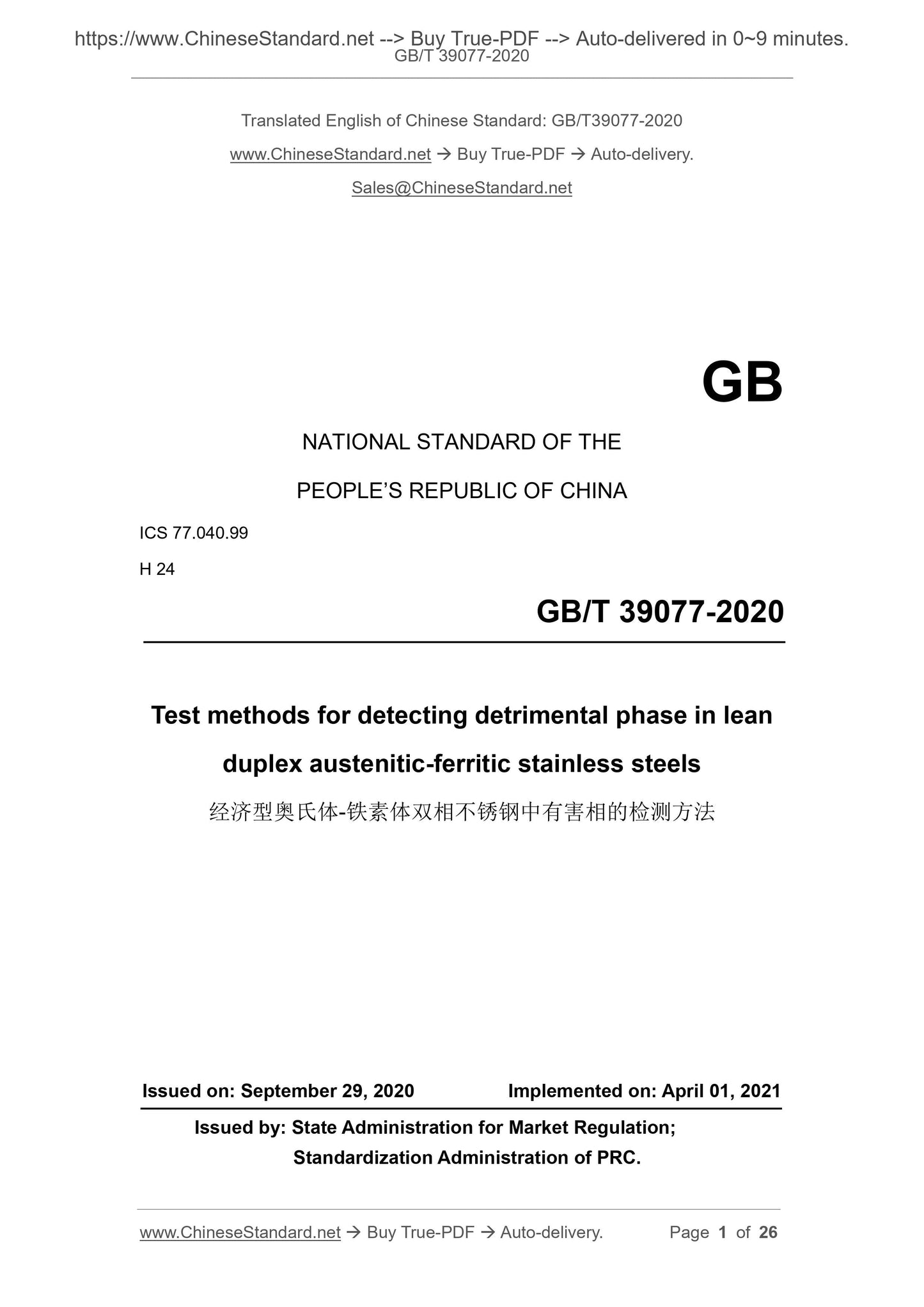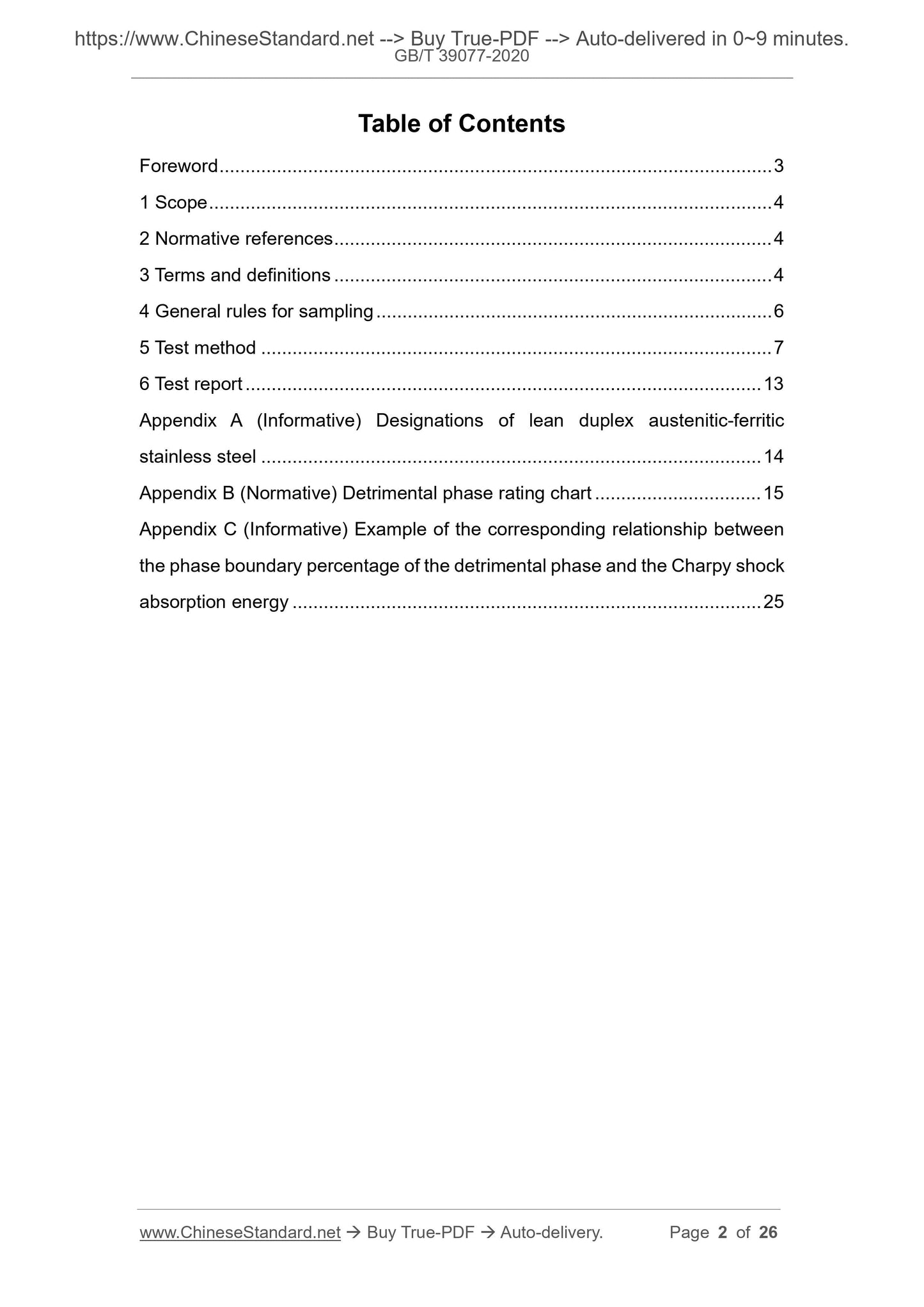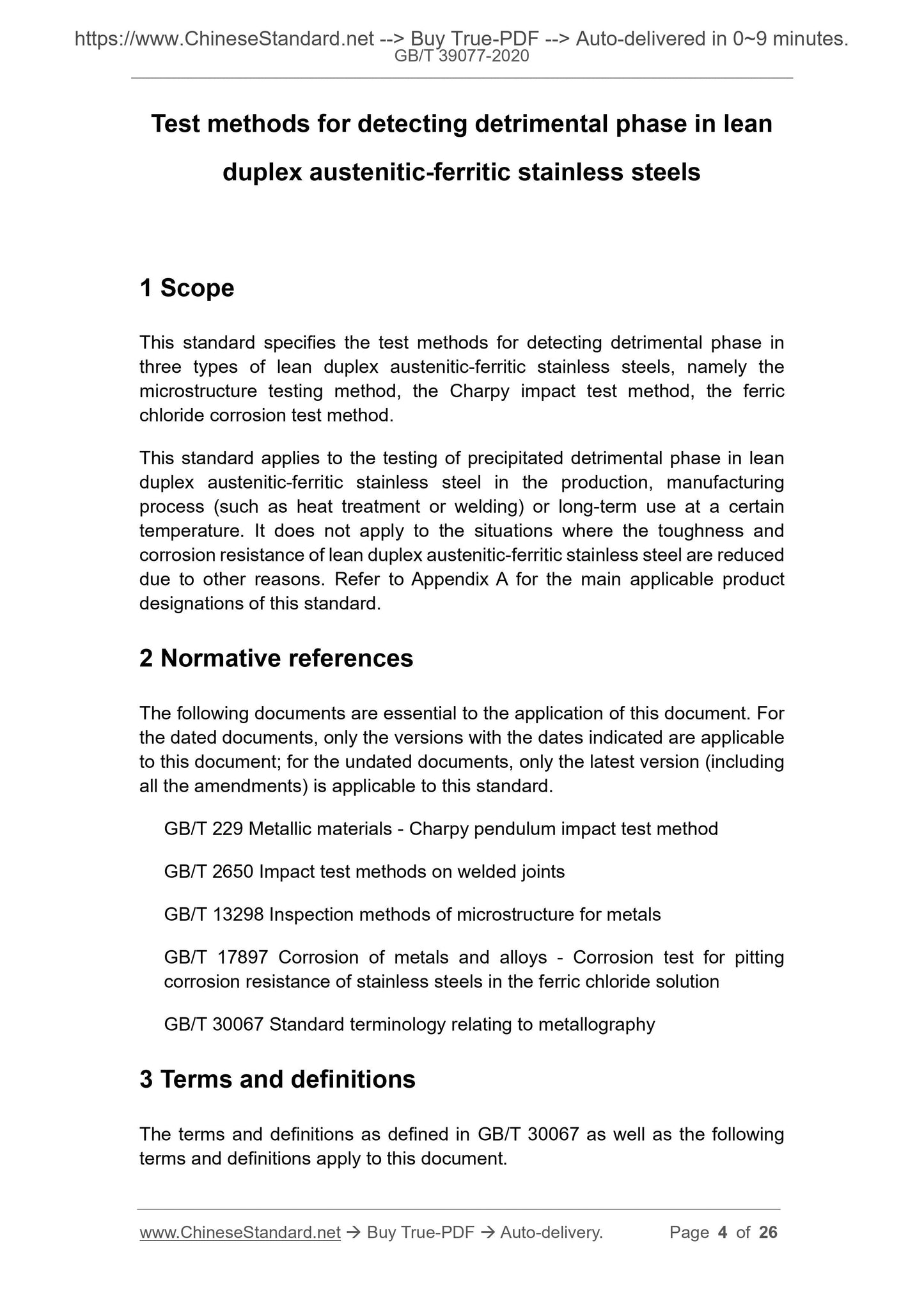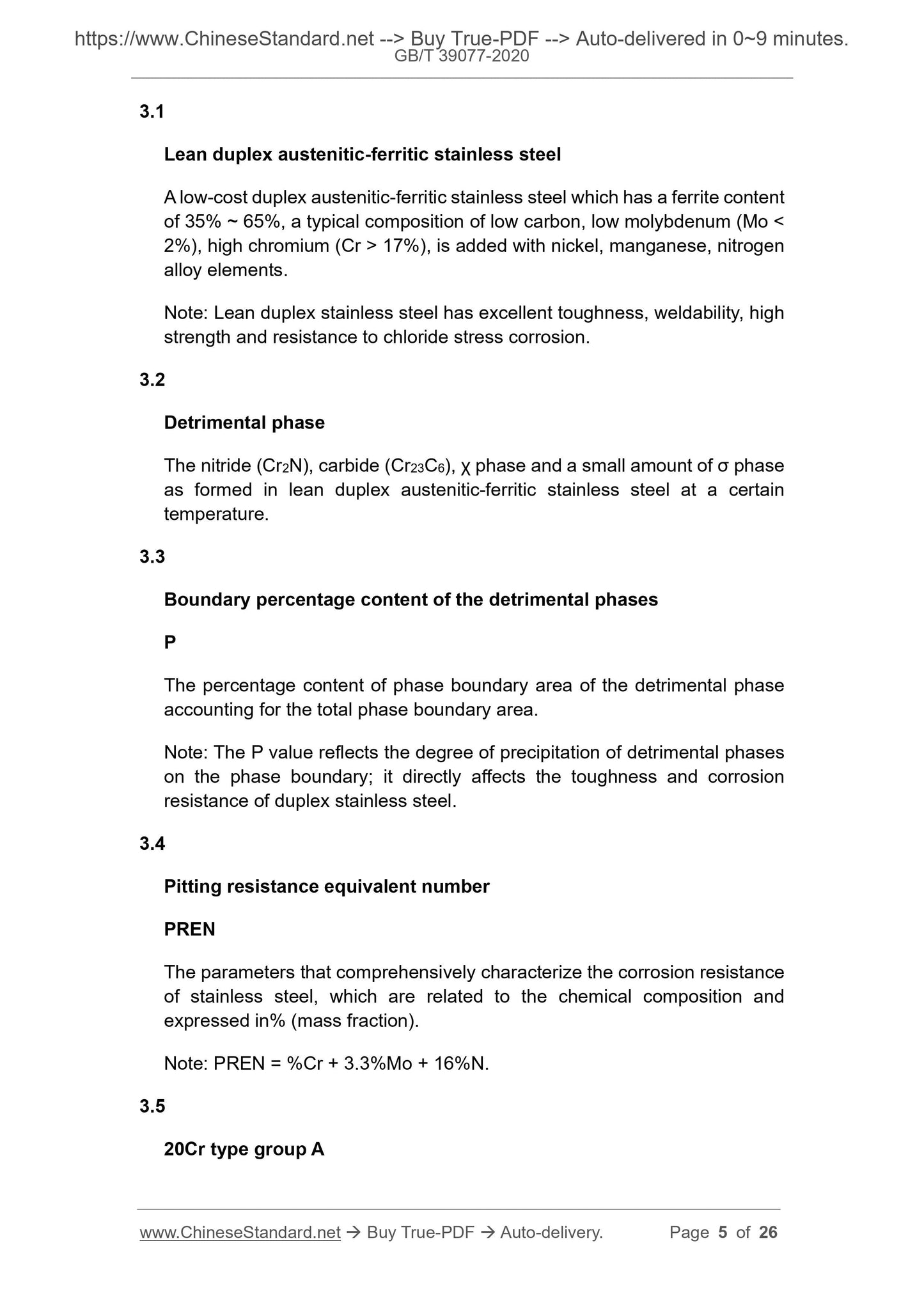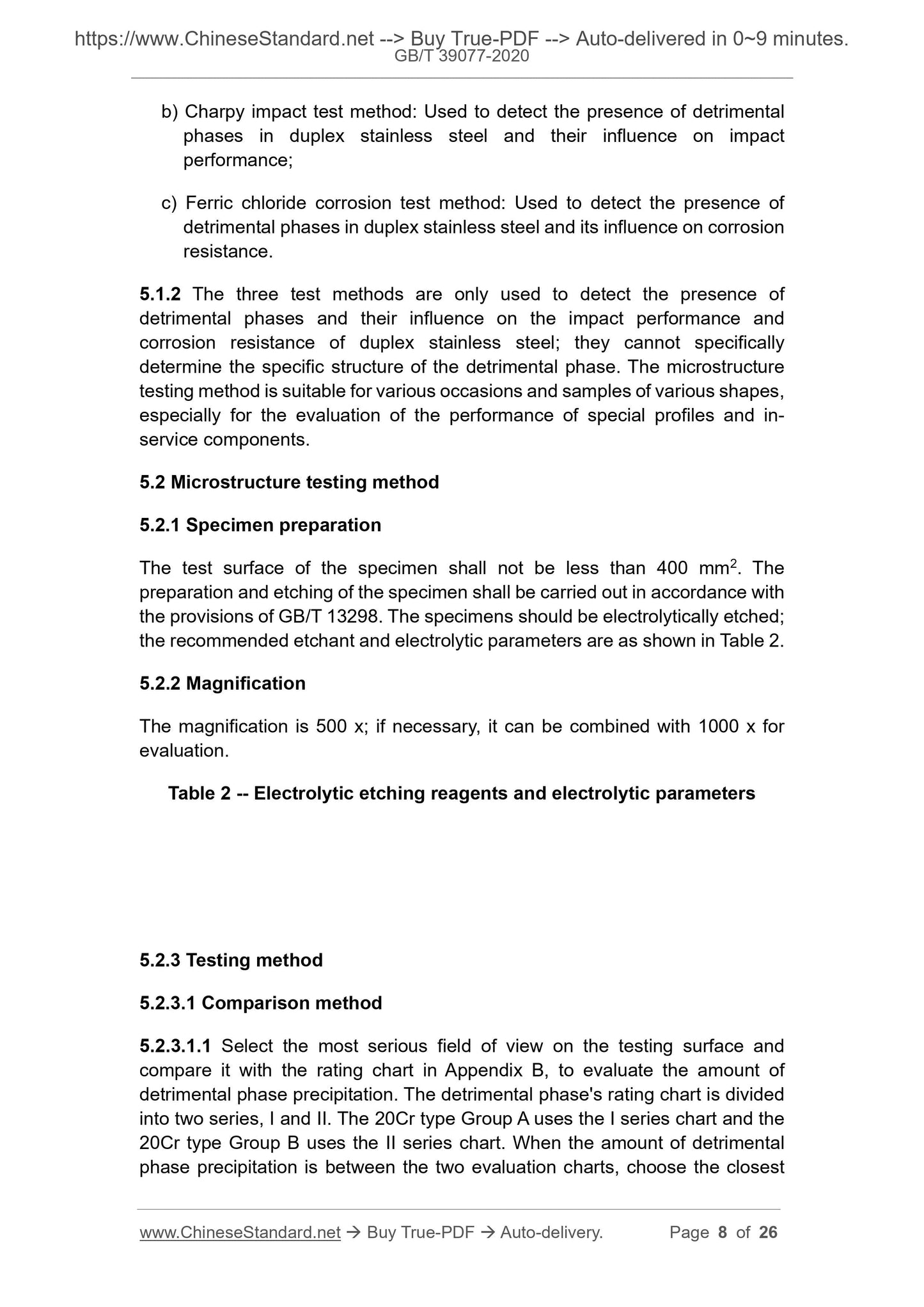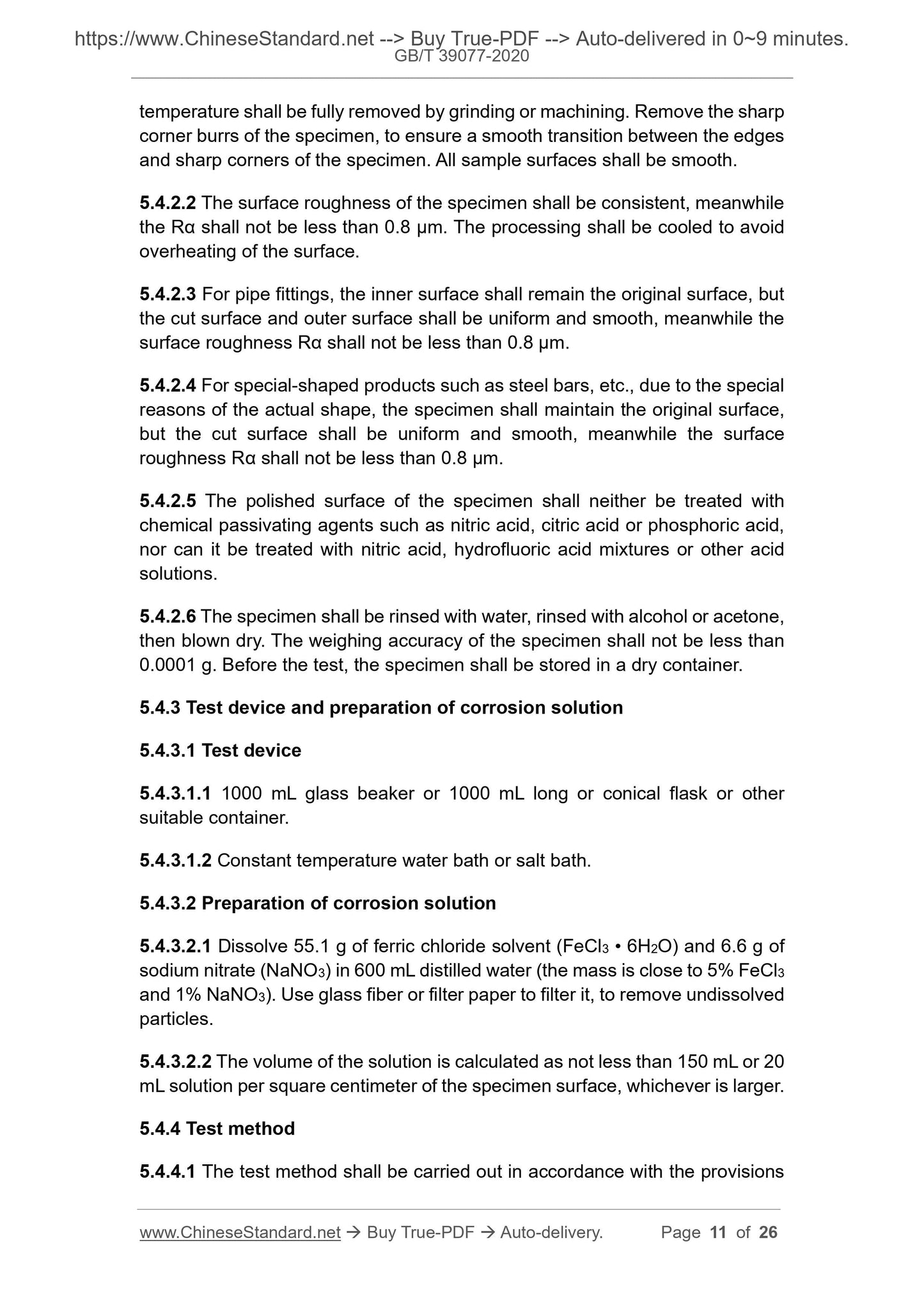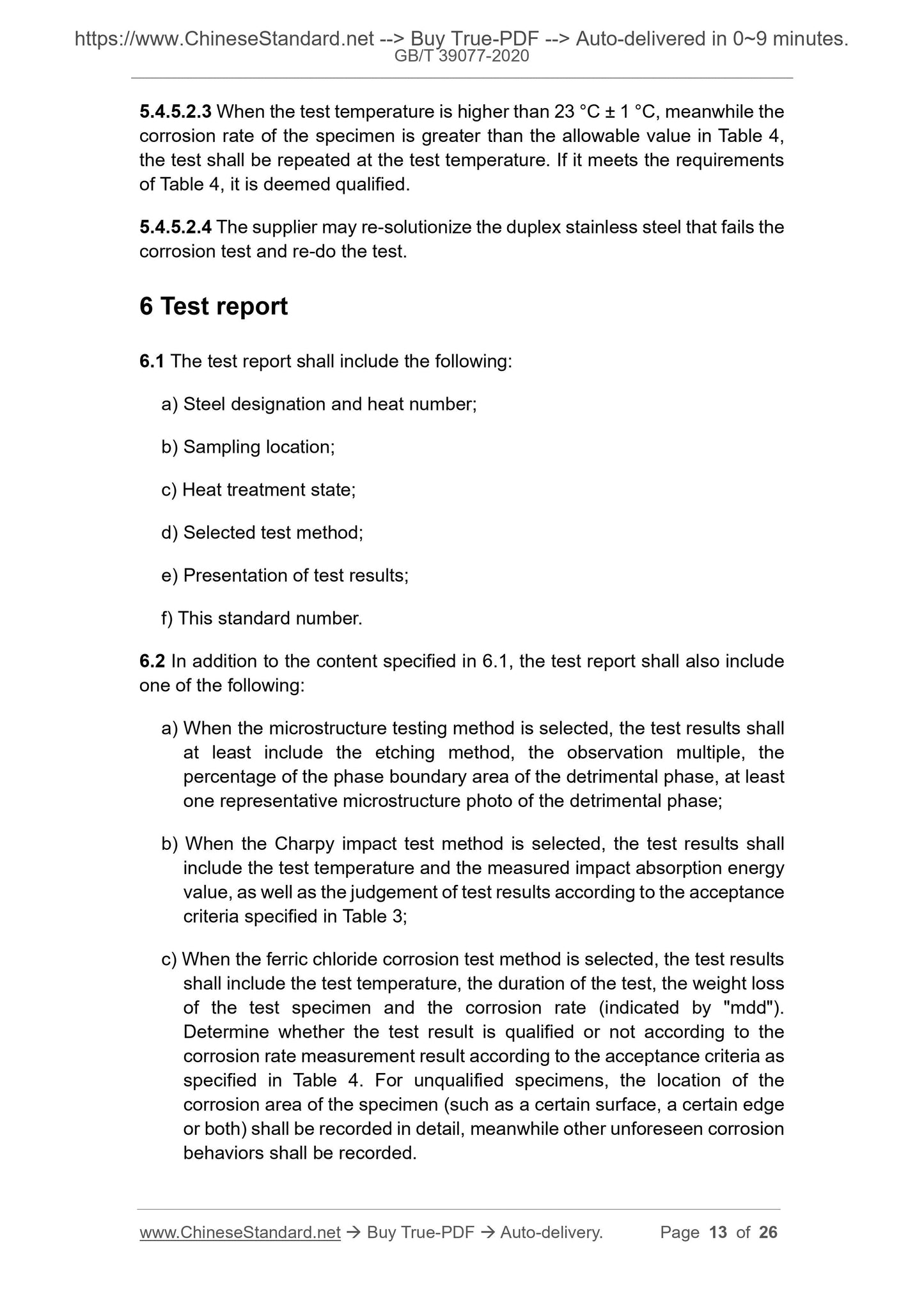1
/
of
7
www.ChineseStandard.us -- Field Test Asia Pte. Ltd.
GB/T 39077-2020 English PDF (GB/T39077-2020)
GB/T 39077-2020 English PDF (GB/T39077-2020)
Regular price
$355.00
Regular price
Sale price
$355.00
Unit price
/
per
Shipping calculated at checkout.
Couldn't load pickup availability
GB/T 39077-2020: Test methods for detecting detrimental phase in lean duplex austenitic-ferritic stainless steels
Delivery: 9 seconds. Download (& Email) true-PDF + Invoice.
Get Quotation: Click GB/T 39077-2020 (Self-service in 1-minute)
Historical versions (Master-website): GB/T 39077-2020
Preview True-PDF (Reload/Scroll-down if blank)
GB/T 39077-2020
GB
NATIONAL STANDARD OF THE
PEOPLE’S REPUBLIC OF CHINA
ICS 77.040.99
H 24
Test methods for detecting detrimental phase in lean
duplex austenitic-ferritic stainless steels
ISSUED ON: SEPTEMBER 29, 2020
IMPLEMENTED ON: APRIL 01, 2021
Issued by: State Administration for Market Regulation;
Standardization Administration of PRC.
Table of Contents
Foreword ... 3
1 Scope ... 4
2 Normative references ... 4
3 Terms and definitions ... 4
4 General rules for sampling ... 6
5 Test method ... 7
6 Test report ... 13
Appendix A (Informative) Designations of lean duplex austenitic-ferritic
stainless steel ... 14
Appendix B (Normative) Detrimental phase rating chart ... 15
Appendix C (Informative) Example of the corresponding relationship between
the phase boundary percentage of the detrimental phase and the Charpy shock
absorption energy ... 25
Test methods for detecting detrimental phase in lean
duplex austenitic-ferritic stainless steels
1 Scope
This standard specifies the test methods for detecting detrimental phase in
three types of lean duplex austenitic-ferritic stainless steels, namely the
microstructure testing method, the Charpy impact test method, the ferric
chloride corrosion test method.
This standard applies to the testing of precipitated detrimental phase in lean
duplex austenitic-ferritic stainless steel in the production, manufacturing
process (such as heat treatment or welding) or long-term use at a certain
temperature. It does not apply to the situations where the toughness and
corrosion resistance of lean duplex austenitic-ferritic stainless steel are reduced
due to other reasons. Refer to Appendix A for the main applicable product
designations of this standard.
2 Normative references
The following documents are essential to the application of this document. For
the dated documents, only the versions with the dates indicated are applicable
to this document; for the undated documents, only the latest version (including
all the amendments) is applicable to this standard.
GB/T 229 Metallic materials - Charpy pendulum impact test method
GB/T 2650 Impact test methods on welded joints
GB/T 13298 Inspection methods of microstructure for metals
GB/T 17897 Corrosion of metals and alloys - Corrosion test for pitting
corrosion resistance of stainless steels in the ferric chloride solution
GB/T 30067 Standard terminology relating to metallography
3 Terms and definitions
The terms and definitions as defined in GB/T 30067 as well as the following
terms and definitions apply to this document.
3.1
Lean duplex austenitic-ferritic stainless steel
A low-cost duplex austenitic-ferritic stainless steel which has a ferrite content
of 35% ~ 65%, a typical composition of low carbon, low molybdenum (Mo <
2%), high chromium (Cr > 17%), is added with nickel, manganese, nitrogen
alloy elements.
Note: Lean duplex stainless steel has excellent toughness, weldability, high
strength and resistance to chloride stress corrosion.
3.2
Detrimental phase
The nitride (Cr2N), carbide (Cr23C6), χ phase and a small amount of σ phase
as formed in lean duplex austenitic-ferritic stainless steel at a certain
temperature.
3.3
Boundary percentage content of the detrimental phases
The percentage content of phase boundary area of the detrimental phase
accounting for the total phase boundary area.
Note: The P value reflects the degree of precipitation of detrimental phases
on the phase boundary; it directly affects the toughness and corrosion
resistance of duplex stainless steel.
3.4
Pitting resistance equivalent number
PREN
The parameters that comprehensively characterize the corrosion resistance
of stainless steel, which are related to the chemical composition and
expressed in% (mass fraction).
Note: PREN = %Cr + 3.3%Mo + 16%N.
3.5
20Cr type group A
b) Charpy impact test method: Used to detect the presence of detrimental
phases in duplex stainless steel and their influence on impact
performance;
c) Ferric chloride corrosion test method: Used to detect the presence of
detrimental phases in duplex stainless steel and its influence on corrosion
resistance.
5.1.2 The three test methods are only used to detect the presence of
detrimental phases and their influence on the impact performance and
corrosion resistance of duplex stainless steel; they cannot specifically
determine the specific structure of the detrimental phase. The microstructure
testing method is suitable for various occasions and samples of various shapes,
especially for the evaluation of the performance of special profiles and in-
service components.
5.2 Microstructure testing method
5.2.1 Specimen preparation
The test surface of the specimen shall not be less than 400 mm2. The
preparation and etching of the specimen shall be carried out in accordance with
the provisions of GB/T 13298. The specimens should be electrolytically etched;
the recommended etchant and electrolytic parameters are as shown in Table 2.
5.2.2 Magnification
The magnification is 500 x; if necessary, it can be combined with 1000 x for
evaluation.
Table 2 -- Electrolytic etching reagents and electrolytic parameters
5.2.3 Testing method
5.2.3.1 Comparison method
5.2.3.1.1 Select the most serious field of view on the testing surface and
compare it with the rating chart in Appendix B, to evaluate the amount of
detrimental phase precipitation. The detrimental phase's rating chart is divided
into two series, I and II. The 20Cr type Group A uses the I series chart and the
20Cr type Group B uses the II series chart. When the amount of detrimental
phase precipitation is between the two evaluation charts, choose the closest
temperature shall be fully removed by grinding or machining. Remove the sharp
corner burrs of the specimen, to ensure a smooth transition between the edges
and sharp corners of the specimen. All sample surfaces shall be smooth.
5.4.2.2 The surface roughness of the specimen shall be consistent, meanwhile
the Rα shall not be less than 0.8 μm. The processing shall be cooled to avoid
overheating of the surface.
5.4.2.3 For pipe fittings, the inner surface shall remain the original surface, but
the cut surface and outer surface shall be uniform and smooth, meanwhile the
surface roughness Rα shall not be less than 0.8 μm.
5.4.2.4 For special-shaped products such as steel bars, etc., due to the special
reasons of the actual shape, the specimen shall maintain the original surface,
but the cut surface shall be uniform and smooth, meanwhile the surface
roughness Rα shall not be less than 0.8 μm.
5.4.2.5 The polished surface of the specimen shall neither be treated with
chemical passivating agents such as nitric acid, citric acid or phosphoric acid,
nor can it be treated with nitric acid, hydrofluoric acid mixtures or other acid
solutions.
5.4.2.6 The specimen shall be rinsed with water, rinsed with alcohol or acetone,
then blown dry. The weighing accuracy of the specimen shall not be less than
0.0001 g. Before the test, the specimen shall be stored in a dry container.
5.4.3 Test device and preparation of corrosion solution
5.4.3.1 Test device
5.4.3.1.1 1000 mL glass beaker or 1000 mL long or conical flask or other
suitable container.
5.4.3.1.2 Constant temperature water bath or salt bath.
5.4.3.2 Preparation of corrosion solution
5.4.3.2.1 Dissolve 55.1 g of ferric chloride solvent (FeCl3 • 6H2O) and 6.6 g of
sodium nitrate (NaNO3) in 600 mL distilled water (the mass is close to 5% FeCl3
and 1% NaNO3). Use glass fiber or filter paper to filter it, to remove undissolved
particles.
5.4.3.2.2 The volume of the solution is calculated as not less than 150 mL or 20
mL solution per square centimeter of the specimen surface, whichever is larger.
5.4.4 Test method
5.4.4.1 The test method shall be carried out in accordance with the provisions
5.4.5.2.3 When the test temperature is higher than 23 °C ± 1 °C, meanwhile the
corrosion rate of the specimen is greater than the allowable value in Table 4,
the test shall be repeated at the test temperature. If it meets the requirements
of Table 4, it is deemed qualified.
5.4.5.2.4 The supplier may re-solutionize the duplex stainless steel that fails the
corrosion test and re-do the test.
6 Test report
6.1 The test report shall include the following:
a) Steel designation and heat number;
b) Sampling location;
c) Heat treatment state;
d) Selected test method;
e) Presentation of test results;
f) This standard number.
6.2 In addition to the content specified in 6.1, the test report shall also include
one of the following:
a) When the microstructure testing method is selected, the test results shall
at least include the etching method, the observation multiple, the
percentage of the phase boundary area of the detrimental phase, at least
one representative microstructure photo of the detrimental phase;
b) When the Charpy impact test method is selected, the test results shall
include the test temperature and the measured impact absorption energy
value, as well as the judgement of test results according to the acceptance
criteria specified in Table 3;
c) When the ferric chloride corrosion test method is selected, the test results
shall include the test temperature, the duration of the test, the weight loss
of the test specimen and the corrosion rate (indicated by "mdd").
Determine whether the test result is qualified or not according to the
corrosion rate measurement result according to the acceptance criteria as
specified in Table 4. For unqualified specimens, the location of the
corrosion area of the specimen (such as a certain surface, a certain edge
or both) shall be recorded in detail, meanwhile other unforeseen corrosion
behaviors shall be recorded.
GB/T 39077-2020
GB
NATIONAL STANDARD OF THE
PEOPLE’S REPUBLIC OF CHINA
ICS 77.040.99
H 24
Test methods for detecting detrimental phase in lean
duplex austenitic-ferritic stainless steels
ISSUED ON: SEPTEMBER 29, 2020
IMPLEMENTED ON: APRIL 01, 2021
Issued by: State Administration for Market Regulation;
Standardization Administration of PRC.
Table of Contents
Foreword ... 3
1 Scope ... 4
2 Normative references ... 4
3 Terms and definitions ... 4
4 General rules for sampling ... 6
5 Test method ... 7
6 Test report ... 13
Appendix A (Informative) Designations of lean duplex austenitic-ferritic
stainless steel ... 14
Appendix B (Normative) Detrimental phase rating chart ... 15
Appendix C (Informative) Example of the corresponding relationship between
the phase boundary percentage of the detrimental phase and the Charpy shock
absorption energy ... 25
Test methods for detecting detrimental phase in lean
duplex austenitic-ferritic stainless steels
1 Scope
This standard specifies the test methods for detecting detrimental phase in
three types of lean duplex austenitic-ferritic stainless steels, namely the
microstructure testing method, the Charpy impact test method, the ferric
chloride corrosion test method.
This standard applies to the testing of precipitated detrimental phase in lean
duplex austenitic-ferritic stainless steel in the production, manufacturing
process (such as heat treatment or welding) or long-term use at a certain
temperature. It does not apply to the situations where the toughness and
corrosion resistance of lean duplex austenitic-ferritic stainless steel are reduced
due to other reasons. Refer to Appendix A for the main applicable product
designations of this standard.
2 Normative references
The following documents are essential to the application of this document. For
the dated documents, only the versions with the dates indicated are applicable
to this document; for the undated documents, only the latest version (including
all the amendments) is applicable to this standard.
GB/T 229 Metallic materials - Charpy pendulum impact test method
GB/T 2650 Impact test methods on welded joints
GB/T 13298 Inspection methods of microstructure for metals
GB/T 17897 Corrosion of metals and alloys - Corrosion test for pitting
corrosion resistance of stainless steels in the ferric chloride solution
GB/T 30067 Standard terminology relating to metallography
3 Terms and definitions
The terms and definitions as defined in GB/T 30067 as well as the following
terms and definitions apply to this document.
3.1
Lean duplex austenitic-ferritic stainless steel
A low-cost duplex austenitic-ferritic stainless steel which has a ferrite content
of 35% ~ 65%, a typical composition of low carbon, low molybdenum (Mo <
2%), high chromium (Cr > 17%), is added with nickel, manganese, nitrogen
alloy elements.
Note: Lean duplex stainless steel has excellent toughness, weldability, high
strength and resistance to chloride stress corrosion.
3.2
Detrimental phase
The nitride (Cr2N), carbide (Cr23C6), χ phase and a small amount of σ phase
as formed in lean duplex austenitic-ferritic stainless steel at a certain
temperature.
3.3
Boundary percentage content of the detrimental phases
The percentage content of phase boundary area of the detrimental phase
accounting for the total phase boundary area.
Note: The P value reflects the degree of precipitation of detrimental phases
on the phase boundary; it directly affects the toughness and corrosion
resistance of duplex stainless steel.
3.4
Pitting resistance equivalent number
PREN
The parameters that comprehensively characterize the corrosion resistance
of stainless steel, which are related to the chemical composition and
expressed in% (mass fraction).
Note: PREN = %Cr + 3.3%Mo + 16%N.
3.5
20Cr type group A
b) Charpy impact test method: Used to detect the presence of detrimental
phases in duplex stainless steel and their influence on impact
performance;
c) Ferric chloride corrosion test meth...
Delivery: 9 seconds. Download (& Email) true-PDF + Invoice.
Get Quotation: Click GB/T 39077-2020 (Self-service in 1-minute)
Historical versions (Master-website): GB/T 39077-2020
Preview True-PDF (Reload/Scroll-down if blank)
GB/T 39077-2020
GB
NATIONAL STANDARD OF THE
PEOPLE’S REPUBLIC OF CHINA
ICS 77.040.99
H 24
Test methods for detecting detrimental phase in lean
duplex austenitic-ferritic stainless steels
ISSUED ON: SEPTEMBER 29, 2020
IMPLEMENTED ON: APRIL 01, 2021
Issued by: State Administration for Market Regulation;
Standardization Administration of PRC.
Table of Contents
Foreword ... 3
1 Scope ... 4
2 Normative references ... 4
3 Terms and definitions ... 4
4 General rules for sampling ... 6
5 Test method ... 7
6 Test report ... 13
Appendix A (Informative) Designations of lean duplex austenitic-ferritic
stainless steel ... 14
Appendix B (Normative) Detrimental phase rating chart ... 15
Appendix C (Informative) Example of the corresponding relationship between
the phase boundary percentage of the detrimental phase and the Charpy shock
absorption energy ... 25
Test methods for detecting detrimental phase in lean
duplex austenitic-ferritic stainless steels
1 Scope
This standard specifies the test methods for detecting detrimental phase in
three types of lean duplex austenitic-ferritic stainless steels, namely the
microstructure testing method, the Charpy impact test method, the ferric
chloride corrosion test method.
This standard applies to the testing of precipitated detrimental phase in lean
duplex austenitic-ferritic stainless steel in the production, manufacturing
process (such as heat treatment or welding) or long-term use at a certain
temperature. It does not apply to the situations where the toughness and
corrosion resistance of lean duplex austenitic-ferritic stainless steel are reduced
due to other reasons. Refer to Appendix A for the main applicable product
designations of this standard.
2 Normative references
The following documents are essential to the application of this document. For
the dated documents, only the versions with the dates indicated are applicable
to this document; for the undated documents, only the latest version (including
all the amendments) is applicable to this standard.
GB/T 229 Metallic materials - Charpy pendulum impact test method
GB/T 2650 Impact test methods on welded joints
GB/T 13298 Inspection methods of microstructure for metals
GB/T 17897 Corrosion of metals and alloys - Corrosion test for pitting
corrosion resistance of stainless steels in the ferric chloride solution
GB/T 30067 Standard terminology relating to metallography
3 Terms and definitions
The terms and definitions as defined in GB/T 30067 as well as the following
terms and definitions apply to this document.
3.1
Lean duplex austenitic-ferritic stainless steel
A low-cost duplex austenitic-ferritic stainless steel which has a ferrite content
of 35% ~ 65%, a typical composition of low carbon, low molybdenum (Mo <
2%), high chromium (Cr > 17%), is added with nickel, manganese, nitrogen
alloy elements.
Note: Lean duplex stainless steel has excellent toughness, weldability, high
strength and resistance to chloride stress corrosion.
3.2
Detrimental phase
The nitride (Cr2N), carbide (Cr23C6), χ phase and a small amount of σ phase
as formed in lean duplex austenitic-ferritic stainless steel at a certain
temperature.
3.3
Boundary percentage content of the detrimental phases
The percentage content of phase boundary area of the detrimental phase
accounting for the total phase boundary area.
Note: The P value reflects the degree of precipitation of detrimental phases
on the phase boundary; it directly affects the toughness and corrosion
resistance of duplex stainless steel.
3.4
Pitting resistance equivalent number
PREN
The parameters that comprehensively characterize the corrosion resistance
of stainless steel, which are related to the chemical composition and
expressed in% (mass fraction).
Note: PREN = %Cr + 3.3%Mo + 16%N.
3.5
20Cr type group A
b) Charpy impact test method: Used to detect the presence of detrimental
phases in duplex stainless steel and their influence on impact
performance;
c) Ferric chloride corrosion test method: Used to detect the presence of
detrimental phases in duplex stainless steel and its influence on corrosion
resistance.
5.1.2 The three test methods are only used to detect the presence of
detrimental phases and their influence on the impact performance and
corrosion resistance of duplex stainless steel; they cannot specifically
determine the specific structure of the detrimental phase. The microstructure
testing method is suitable for various occasions and samples of various shapes,
especially for the evaluation of the performance of special profiles and in-
service components.
5.2 Microstructure testing method
5.2.1 Specimen preparation
The test surface of the specimen shall not be less than 400 mm2. The
preparation and etching of the specimen shall be carried out in accordance with
the provisions of GB/T 13298. The specimens should be electrolytically etched;
the recommended etchant and electrolytic parameters are as shown in Table 2.
5.2.2 Magnification
The magnification is 500 x; if necessary, it can be combined with 1000 x for
evaluation.
Table 2 -- Electrolytic etching reagents and electrolytic parameters
5.2.3 Testing method
5.2.3.1 Comparison method
5.2.3.1.1 Select the most serious field of view on the testing surface and
compare it with the rating chart in Appendix B, to evaluate the amount of
detrimental phase precipitation. The detrimental phase's rating chart is divided
into two series, I and II. The 20Cr type Group A uses the I series chart and the
20Cr type Group B uses the II series chart. When the amount of detrimental
phase precipitation is between the two evaluation charts, choose the closest
temperature shall be fully removed by grinding or machining. Remove the sharp
corner burrs of the specimen, to ensure a smooth transition between the edges
and sharp corners of the specimen. All sample surfaces shall be smooth.
5.4.2.2 The surface roughness of the specimen shall be consistent, meanwhile
the Rα shall not be less than 0.8 μm. The processing shall be cooled to avoid
overheating of the surface.
5.4.2.3 For pipe fittings, the inner surface shall remain the original surface, but
the cut surface and outer surface shall be uniform and smooth, meanwhile the
surface roughness Rα shall not be less than 0.8 μm.
5.4.2.4 For special-shaped products such as steel bars, etc., due to the special
reasons of the actual shape, the specimen shall maintain the original surface,
but the cut surface shall be uniform and smooth, meanwhile the surface
roughness Rα shall not be less than 0.8 μm.
5.4.2.5 The polished surface of the specimen shall neither be treated with
chemical passivating agents such as nitric acid, citric acid or phosphoric acid,
nor can it be treated with nitric acid, hydrofluoric acid mixtures or other acid
solutions.
5.4.2.6 The specimen shall be rinsed with water, rinsed with alcohol or acetone,
then blown dry. The weighing accuracy of the specimen shall not be less than
0.0001 g. Before the test, the specimen shall be stored in a dry container.
5.4.3 Test device and preparation of corrosion solution
5.4.3.1 Test device
5.4.3.1.1 1000 mL glass beaker or 1000 mL long or conical flask or other
suitable container.
5.4.3.1.2 Constant temperature water bath or salt bath.
5.4.3.2 Preparation of corrosion solution
5.4.3.2.1 Dissolve 55.1 g of ferric chloride solvent (FeCl3 • 6H2O) and 6.6 g of
sodium nitrate (NaNO3) in 600 mL distilled water (the mass is close to 5% FeCl3
and 1% NaNO3). Use glass fiber or filter paper to filter it, to remove undissolved
particles.
5.4.3.2.2 The volume of the solution is calculated as not less than 150 mL or 20
mL solution per square centimeter of the specimen surface, whichever is larger.
5.4.4 Test method
5.4.4.1 The test method shall be carried out in accordance with the provisions
5.4.5.2.3 When the test temperature is higher than 23 °C ± 1 °C, meanwhile the
corrosion rate of the specimen is greater than the allowable value in Table 4,
the test shall be repeated at the test temperature. If it meets the requirements
of Table 4, it is deemed qualified.
5.4.5.2.4 The supplier may re-solutionize the duplex stainless steel that fails the
corrosion test and re-do the test.
6 Test report
6.1 The test report shall include the following:
a) Steel designation and heat number;
b) Sampling location;
c) Heat treatment state;
d) Selected test method;
e) Presentation of test results;
f) This standard number.
6.2 In addition to the content specified in 6.1, the test report shall also include
one of the following:
a) When the microstructure testing method is selected, the test results shall
at least include the etching method, the observation multiple, the
percentage of the phase boundary area of the detrimental phase, at least
one representative microstructure photo of the detrimental phase;
b) When the Charpy impact test method is selected, the test results shall
include the test temperature and the measured impact absorption energy
value, as well as the judgement of test results according to the acceptance
criteria specified in Table 3;
c) When the ferric chloride corrosion test method is selected, the test results
shall include the test temperature, the duration of the test, the weight loss
of the test specimen and the corrosion rate (indicated by "mdd").
Determine whether the test result is qualified or not according to the
corrosion rate measurement result according to the acceptance criteria as
specified in Table 4. For unqualified specimens, the location of the
corrosion area of the specimen (such as a certain surface, a certain edge
or both) shall be recorded in detail, meanwhile other unforeseen corrosion
behaviors shall be recorded.
GB/T 39077-2020
GB
NATIONAL STANDARD OF THE
PEOPLE’S REPUBLIC OF CHINA
ICS 77.040.99
H 24
Test methods for detecting detrimental phase in lean
duplex austenitic-ferritic stainless steels
ISSUED ON: SEPTEMBER 29, 2020
IMPLEMENTED ON: APRIL 01, 2021
Issued by: State Administration for Market Regulation;
Standardization Administration of PRC.
Table of Contents
Foreword ... 3
1 Scope ... 4
2 Normative references ... 4
3 Terms and definitions ... 4
4 General rules for sampling ... 6
5 Test method ... 7
6 Test report ... 13
Appendix A (Informative) Designations of lean duplex austenitic-ferritic
stainless steel ... 14
Appendix B (Normative) Detrimental phase rating chart ... 15
Appendix C (Informative) Example of the corresponding relationship between
the phase boundary percentage of the detrimental phase and the Charpy shock
absorption energy ... 25
Test methods for detecting detrimental phase in lean
duplex austenitic-ferritic stainless steels
1 Scope
This standard specifies the test methods for detecting detrimental phase in
three types of lean duplex austenitic-ferritic stainless steels, namely the
microstructure testing method, the Charpy impact test method, the ferric
chloride corrosion test method.
This standard applies to the testing of precipitated detrimental phase in lean
duplex austenitic-ferritic stainless steel in the production, manufacturing
process (such as heat treatment or welding) or long-term use at a certain
temperature. It does not apply to the situations where the toughness and
corrosion resistance of lean duplex austenitic-ferritic stainless steel are reduced
due to other reasons. Refer to Appendix A for the main applicable product
designations of this standard.
2 Normative references
The following documents are essential to the application of this document. For
the dated documents, only the versions with the dates indicated are applicable
to this document; for the undated documents, only the latest version (including
all the amendments) is applicable to this standard.
GB/T 229 Metallic materials - Charpy pendulum impact test method
GB/T 2650 Impact test methods on welded joints
GB/T 13298 Inspection methods of microstructure for metals
GB/T 17897 Corrosion of metals and alloys - Corrosion test for pitting
corrosion resistance of stainless steels in the ferric chloride solution
GB/T 30067 Standard terminology relating to metallography
3 Terms and definitions
The terms and definitions as defined in GB/T 30067 as well as the following
terms and definitions apply to this document.
3.1
Lean duplex austenitic-ferritic stainless steel
A low-cost duplex austenitic-ferritic stainless steel which has a ferrite content
of 35% ~ 65%, a typical composition of low carbon, low molybdenum (Mo <
2%), high chromium (Cr > 17%), is added with nickel, manganese, nitrogen
alloy elements.
Note: Lean duplex stainless steel has excellent toughness, weldability, high
strength and resistance to chloride stress corrosion.
3.2
Detrimental phase
The nitride (Cr2N), carbide (Cr23C6), χ phase and a small amount of σ phase
as formed in lean duplex austenitic-ferritic stainless steel at a certain
temperature.
3.3
Boundary percentage content of the detrimental phases
The percentage content of phase boundary area of the detrimental phase
accounting for the total phase boundary area.
Note: The P value reflects the degree of precipitation of detrimental phases
on the phase boundary; it directly affects the toughness and corrosion
resistance of duplex stainless steel.
3.4
Pitting resistance equivalent number
PREN
The parameters that comprehensively characterize the corrosion resistance
of stainless steel, which are related to the chemical composition and
expressed in% (mass fraction).
Note: PREN = %Cr + 3.3%Mo + 16%N.
3.5
20Cr type group A
b) Charpy impact test method: Used to detect the presence of detrimental
phases in duplex stainless steel and their influence on impact
performance;
c) Ferric chloride corrosion test meth...
Share
